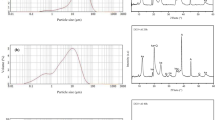Abstract
The mechanochemical transformation of Ca(OH)2–(NH4)2HPO4 with different Ca/P ratios 1; 1.5; 1.67 and 1.75 was carried out for different periods of time from 10 min to 24 h in a horizontal vibration mill using steel and agate vials and balls. The phase transformations obtained at each milling stage were characterized by X-ray diffraction, infrared spectroscopy and transmission electron microscopy. Complete transformation to hydroxyapatite took place during the first 5 h of milling, for Ca/P ratios 1.5 to 1.7, when milling was carried out with steel vials and balls. The contamination was not significant for the periods of milling studied for both milling media.











Similar content being viewed by others
References
Sergo V, Sbaizero O, Clarke DR. Mechanical and chemical consequences of the residual stresses in plasma sprayed hydroxyapatite coatings. Biomaterials. 1997;18:477.
Silva CC, Pinheiro AG, Miranda MAR, Góes JC, Sombra ASB. Structural properties of hydroxyapatite obtained by mechanosynthesis. Solid State Sci. 2003;5:553.
Fernandez E, Gil F, Ginebra M, Driessens F, Planell J. Calcium phosphate bone cements for clinical applications. J Mater Sci: Mater Med. 1999;10:177.
Fanovich J, Porto J. Influence of temperature and additives on the microstructure and sintering behaviour of hydroxyapatites with different Ca/P ratios. J Mater Med. 1998;9:53.
Suchananek W, Yoshimura M. Processing and properties of hydroxyapatite-based biomaterials for use as hard tissue replacement implants. J Mater Res. 1998;13:94.
Yamashita K, Kanazawa T. Inorganic phosphate materials. Amsterdam, The Netherlands: Kodansha & Elsevier; 1989. p. 15.
Legeros RZ. Calcium phosphates in oral biology and medicine. Basel, Switzerland: Kager AG; 1991. p. 201.
Yoshimura M, Suda H. Hydroxyapatite and related compounds. Boca Raton, FL: CRC Press; 1994. p. 45.
Elliot JC. Structure and chemistry of the apatites and other calcium orthophosphates. Amsterdam, The Netherlands: Elsevier; 1994.
Suchanek W, Suda H, Yashima M, Kakihana M, Yoshimura M. Biocompatible whiskers with controlled morphology and stoichiometry. J Mater Res. 1995;10:521.
Liou S-C, Chen S-Y. Transformation mechanism of different chemically precipitated apatitic precursors into β-tricalcium phosphate upon calcinations. Biomaterials. 2002;23:4541.
Kim W, Zhang Q, Saito F. Mechanochemical synthesis of hydroxyapatite from Ca(OH)2–P2O5 and CaO–Ca(OH)2–P2O5 mixtures. J Mater Sci. 2000;35:5401.
Spadavecchia U, González G. Obtención de hidroxiapatita manométrica para aplicaciones médicas. Rev Fac Ing. 2007;22(4):37.
Kim W, Saito F. Mechanochemical síntesis of hydroxyapatite from constituent powder mixtures by dry grinding. J Chem Eng Jpn. 2000;35:768.
Yeong B, Junmin X, Wang J. Mechanochemical síntesis of hydroxyapatite from calcium oxide and brushite. J Am Ceram Soc. 2001;84:465.
Mochales C, El Briak-BenAbdeslam H, Ginebra MP, Terol A, Planell JA, Boudeville P. Dry mechanochemical synthesis of hydroxyapatites from DCPD and CaO: influence of instrumental parameters on the reaction kinetics. Biomaterials. 2004;25:1151.
Gonzalez G, Villalba R, Sargarzazu A. Synthesis of biomaterials by mechanochemical transformation. Mater Sci Forum. 2002;386–388:645.
González G, Sagarzazu A, Villalba R. Mechanochemical transformation of mixtures of Ca(OH)2 and (NH4)2 HPO4 or P2O5. Mater Res Bull. 2006;41(10):1902.
Gutman E. Mechanochemistry of materials. Cambridge, UK: Cambridge International Science; 1997.
Koutsopoulos S. Synthesis and characterization of hydroxyapatite crystal: a review study on the analytical methods. J Biomed Mater Res. 2002;62:600.
Cahil A, Soptrajanov B, Najdoski M, Lutz HD, Engelen B, Stefov V. Infrared and Raman spectra of magnesium ammonium phosphate hexahydrate (struvite) and its isomorphous analogues. Part VI: FT-IR spectra of isomorphously isolated species. NH4 + ions isolated in MKPO4·6H2O (M = Mg; Ni) and PO4 –3 ions isolated in MgNH4AsO4·6H2O. J Mol Struct. 2008;876:255.
LeGeros RZ. Biologically relevant calcium phosphates. In: Myers HM, editor. Calcium phosphates in oral biology and medicine. London: Basel; San Francisco: Karger; 1991. p. 4–45.
Farmer VC. The vibrations of protons in minerals: hydroxyl, water and ammonium. In: Farmer VC, editor. The Infrared spectra of minerals. London: Mineralogical Society; 1974. p. 137–182.
Ishikawas K, Ducheyne P, Radin S. Determination of the ratio in calcium-deficient hydroxyapatite using X-ray diffraction analysis. J Mater Sci: Mater Med. 1993;4:165.
Mostafa NY. Characterization, thermal stability and sintering of hydroxyapatite powders prepared by different routes. Mater Chem Phys. 2005;94:333.
Acknowledgements
The authors gratefully acknowledge the FONACIT projects No. LAB-1998003690 and G-2001000900 for financial support.
Author information
Authors and Affiliations
Corresponding author
Rights and permissions
About this article
Cite this article
Salas, J., Benzo, Z., Gonzalez, G. et al. Effect of Ca/P ratio and milling material on the mechanochemical preparation of hydroxyapaptite. J Mater Sci: Mater Med 20, 2249–2257 (2009). https://doi.org/10.1007/s10856-009-3804-3
Received:
Accepted:
Published:
Issue Date:
DOI: https://doi.org/10.1007/s10856-009-3804-3




